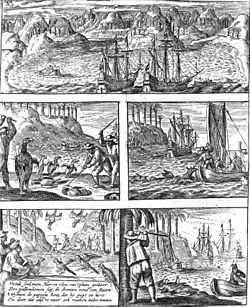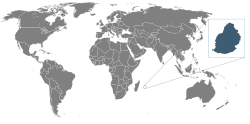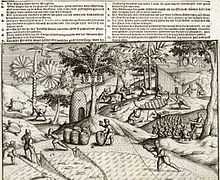Mascarene grey parakeet
| Mascarene grey parakeet | |
|---|---|
 | |
| Engraving depicting the killing of parrots (bottom, possibly this species) and other animals on Mauritius in 1602 | |
| Conservation status | |
| Scientific classification | |
| Kingdom: | Animalia |
| Phylum: | Chordata |
| Class: | Aves |
| Order: | Psittaciformes |
| Family: | Psittacidae |
| Genus: | Psittacula |
| Species: | Psittacula bensoni (Holyoak, 1973) |
 | |
| Location of Mauritius, where subfossils of this species have been found | |
| Synonyms | |
|
Lophopsittacus bensoni Holyoak, 1973 | |
The Mascarene grey parakeet, Thirioux’s grey parrot, or the Mauritius grey parrot (Psittacula bensoni), is an extinct species of parakeet which was endemic to the Mascarene islands of Mauritius and Réunion in the western Indian Ocean. It has been classified as a member of the tribe Psittaculini, along with other parrots from the islands.
Subfossil bones, found on Mauritius and thought to be of the Mascarene grey parakeet, were first described in 1973 as belonging to a relative of the larger broad-billed parrot (also classified as a member of Psittaculini). The subfossils were later connected with 17th- and 18th-century descriptions of small grey parrots on Mauritius and Réunion, together with a single illustration published in a journal describing a voyage in 1602. However, in 2007, the remains were found to belong to a species of Psittacula instead.
The Mascarene grey parakeet was grey, had a long tail, and was larger than other species of the Psittacula genus, which are usually green. The grey parrots were said to be easy to hunt, as the capture of one would result in its calling out to summon the whole flock. They were also considered to be crop pests and being such easy prey meant that they were heavily culled. Coupled with deforestation, this pushed them into extinction. This had happened by the 1730s on Réunion and by the 1760s on Mauritius.
Taxonomy
.jpg)
In 1973, D. T. Holyoak described some small parrot bones that he had discovered among a collection of broad-billed parrot (Lophopsittacus mauritianus) subfossils in the Zoology Museum of Cambridge University. The remains had been collected by Louis Etienne Thirioux in the early 20th century who had found them in a cave on Le Pouce mountain, Mauritius. These were placed in the zoology museum by 1908. Holyoak did not find the bones to be distinct from those of the Mascarene parrot genera Mascarinus, Necropsittacus and Psittacula, other than their size and robustness. He considered them all to be closely related, and provisionally placed the new species in the same genus as the broad-billed parrot, naming it Lophopsittacus bensoni. This was in honour of the ornithologist C. W. Benson, for his work on birds from the Indian Ocean, and in classifying bird collections at Cambridge.[2] The holotype is a mandibular symphysis, with the specimen number UMZC 577a.[3] The species has since been excavated from the Mare aux Songes swamp, where subfossils of most of the other Mauritian bird species have been found and identified.[4]
Old, vague accounts of several different Mascarene parrots have created much confusion for the scientists who subsequently examined them.[5] James Greenway speculated that reports of grey Mauritian parrots referred to the broad-billed parrot.[6] In 1987, Anthony S. Cheke correlated the subfossils with 17th- and 18th-century descriptions of previously unidentified small, grey parrots on Mauritius and Réunion, which had previously been ignored, or simply considered references to broad-billed parrots.[7] In 2007, the English palaeontologist Julian Hume reclassified the species as a member of the genus Psittacula, as he found it to be generically distinct from Lophopsittacus, but morphologically similar to the Alexandrine parakeet (Psittacula eupatria). He also coined the new common name "Thirioux's grey parrot", in honour of the original collector.[3]
It is believed that the Réunion population of grey parrots (referred to as Psittacula cf. bensoni by Hume) was conspecific with that on Mauritius, but it has also been referred to the genus Coracopsis by Charles Coquerel and A. Vinson in the 1860s. Fossils of neither that genus nor Psittacula have ever been found on Réunion. Whilst Coracopsis parrots are known to have been introduced to that island in the 1700s, a population did not become established.[3] No live or dead Mascarene grey parakeets are known to have been exported.[8] An unidentified brown parrot specimen housed in Cabinet du Roi was described by Comte de Buffon in 1779. Julian Hume has suggested the possibility that this might have been a discoloured old Mascarene grey parakeet, if not a lesser vasa parrot (Coracopsis nigra). The specimen is now lost.[3]
Evolution
The Alexandrine parakeet has been proposed as the founder population for all Psittacula species on Indian Ocean islands, during southwards colonisation from its native South Asia. Features of that species gradually disappear in species further away from its range. Many endemic Mascarene birds, including the dodo, are descended from South Asian ancestors, and Julian Hume has proposed that this may also be the case for all the parrots there. Sea levels were lower during the Pleistocene, so it was possible for species to colonise some of these less isolated islands.[9]
Although most extinct parrot species of the Mascarenes are poorly known, subfossil remains show that they shared common features such as enlarged heads and jaws, reduced pectoral bones, and robust leg bones. Hume has suggested that they have a common origin in the radiation of the Psittaculini tribe, basing his theory on morphological features and the fact that Psittacula parrots have managed to colonise many isolated islands in the Indian Ocean.[3] The Psittaculini could have invaded the area several times, as many of the species were so specialised that they may have evolved significantly on hotspot islands before the Mascarenes emerged from the sea.[9] A 2011 genetic study instead found that the Mascarene parrot (Mascarinus mascarinus) of Réunion was most closely related to the lesser vasa parrot (Coracopsis nigra) from Madagascar and nearby islands, and therefore unrelated to the Psittacula parrots, undermining the theory of their common origin.[10]
Description
Contemporary accounts describe the Mascarene grey parakeet as a grey, long-tailed parrot. Subfossils show that its beak was about 30% longer than that of the sympatric Mauritius parakeet, and that it had a comparatively broad bill. Members of the Psittacula genus commonly have large, red beaks, and long tail feathers, with the central ones being the longest. It also differed from its congeners in other osteological details. It was skeletally similar to the Alexandrine parakeet, but some of its bones were larger and more robust. Its colouration also separated it from all other members of Psittacula, the majority of which are green or partially green. The grey parrots from Réunion were described as being larger than the sympatric Réunion parakeet (Psittacula eques).[3]
Behaviour and ecology
According to Anthony S. Cheke and Julian Hume, the anatomy of the Mascarene grey parakeet suggests that its habits were largely terrestrial.[9] Like the extinct Mauritian duck and the Mascarene coot, it appears that the Mascarene grey parakeet inhabited both Mauritius and Réunion. Both populations were said to be easy to hunt by capturing one individual and making it call out, which would summon an entire flock.[3]

The Dutch Captain Willem van West-Zanen, who visited Mauritius in 1602, was the first to mention grey parrots there, and he also described the hunting methods used:
... some of the people went bird hunting. They could grab as many birds as they wished and could catch them by hand. It was an entertaining sight to see. The grey parrots are especially tame and if one is caught and made to cry out, soon hundreds of the birds fly around ones’ ears, which were then hit to the ground with little sticks.[3]
The Dutch sailor Willem Ysbrandtszoon Bontekoe was on Réunion in 1618, and described the same behaviour, in the first account of the grey parrots there:
Coming further inland we found [a] great number of geese, doves, grey parrots and other birds, also many land-turtles... And what we most did marvel at, when we held one of the parrots and other birds and squeezed it till it screamed, there came all the others from thereabout as if they would free it and let themselves be caught as well, so we had enough of them to eat.[3]

In 1705, Feuilley gave a more detailed description of the parrots of Réunion and their ecology:
There are several sorts of parrot, of different sizes and colours. Some are the size of a hen, grey, the beak red [Mascarinus mascarinus]; others the same colour the size of a pigeon [Psittacula bensoni], and yet others, smaller, are green [Psittacula eques]. There are great quantities, especially in the Sainte-Suzanne area and on the mountainsides. They are very good to eat, especially when they are fat, which is from the month of June until the month of September, because at that time the trees produce a certain wild seed that these birds eat.[3]
Many other endemic species of Mauritius and Réunion were lost after the arrival of man, so that the ecosystems of these islands are severely damaged and hard to reconstruct. Before humans arrived, the islands were entirely covered in forests, very little of which remains today, because of deforestation.[11] The surviving endemic fauna is still seriously threatened.[12] On Mauritius, the Mascarene grey parakeet lived alongside other recently extinct birds such as the dodo, the red rail, the broad-billed parrot, the Mauritius blue pigeon, the Mauritius owl, the Mascarene coot, the Mauritian shelduck, the Mauritian duck, and the Mauritius night heron. On Réunion, it lived alongside the Réunion ibis, the hoopoe starling, the Mascarene parrot, the Réunion parakeet, the Réunion swamphen, the Réunion owl, the Réunion night heron, and the Réunion pink pigeon.[9]
Extinction

To the sailors who visited the Mascarene islands from 1598 onwards, the fauna was mainly interesting from a culinary standpoint.[5] Of the eight or so parrot species endemic to the Mascarenes, only the Mauritius parakeet (Psittacula echo) has survived. The others were likely all made extinct by a combination of excessive hunting and deforestation. Due to being easily caught, the Mascarene grey parakeet was often hunted in abundance by early visitors to Mauritius and Réunion. As they fattened themselves from June to September, they were particularly sought after at this time of the year. An account by Admiral Steven van der Hagen from 1606 even suggests that the grey parrots of Mauritius were sometimes killed for amusement.[3]
In the 1720s, Sieur Dubois stated that the grey parrots on Réunion were especially sought after during their fat season, and also claimed they were crop-pests:
Grey parrots, as good [to eat] as the pigeons... All the birds of this island have their season at different times, being six months in the low country and six months in the mountains, when returning, they are very fat and good to eat... The sparrows [Foudia], grey parrots, pigeons and other birds, bats [Pteropus sp.], cause plenty of damage, some to cereals others to fruit.[3]
The fact that they were said to damage crops probably contributed to their being excessively hunted. The French began to clear forests using the slash-and-burn technique for deforestation in the 1730s, which in itself would have had a large effect on the parrot population and on the other animals that nest in tree cavities.[3]
The grey parrots appear to have been common on Mauritius until the 1750s in spite of the pressure from humans, but since they were last mentioned by Cossigny in 1759 (published in 1764), they must have become extinct shortly after this time.[8] The grey parrots of Réunion were last mentioned in 1732, also by Cossigny. This final account gives an insight as to how he regarded the culinary quality of Réunion parrots:

The woods are full of parrots, either completely grey [Psittacula bensoni] or completely green [Psittacula eques]. They were eaten a lot formerly, the grey especially, but both are always lean and very tough whatever sauce one puts on them.[3]
An engraving accompanying the 1648 published version of Willem Van West-Zanen's journal depicts the killing of parrots, dodos, and a dugong on Mairitius in 1602. This hunting method matches that used on Mascarene grey parakeets, so Julian Hume believes it is the only definite depiction of this species.[3] The engraving was captioned with a Dutch poem, here in Hugh Strickland's 1848 translation:
For food the seamen hunt the flesh of feathered fowl,
They tap the palms, and round-rumped dodos they destroy,
The parrot's life they spare that he may peep and howl,
And thus his fellows to imprisonment decoy.[13]
References
- ↑ BirdLife International (2012). "Lophopsittacus bensoni". IUCN Red List of Threatened Species. Version 2012.1. International Union for Conservation of Nature. Retrieved 16 July 2012.
- ↑ Holyoak, D. T. (1973). "An undescribed extinct parrot from Mauritius". Ibis 115 (3): 417–419. doi:10.1111/j.1474-919X.1973.tb01980.x.
- ↑ 3.0 3.1 3.2 3.3 3.4 3.5 3.6 3.7 3.8 3.9 3.10 3.11 3.12 3.13 3.14 Hume, J. P. (2007). "Reappraisal of the parrots (Aves: Psittacidae) from the Mascarene Islands, with comments on their ecology, morphology, and affinities". Zootaxa 1513: 4–21.
- ↑ Rijsdijk, K. F.; Hume, J. P.; Bunnik, F.; Florens, F. B. V.; Baider, C.; Shapiro, B.; van der Plicht, H.; Janoo, A. et al. (January 2009). "Mid-Holocene vertebrate bone Concentration-Lagerstätte on oceanic island Mauritius provides a window into the ecosystem of the dodo (Raphus cucullatus)". Quaternary Science Reviews 28 (1–2): 14–24. Bibcode:2009QSRv...28...14R. doi:10.1016/j.quascirev.2008.09.018. (subscription required (help)).
- ↑ 5.0 5.1 Fuller, E. (2001). Extinct Birds (revised ed.). New York: Comstock. pp. 230–231. ISBN 0-8014-3954-X.
- ↑ Greenway, J. C. (1967). Extinct and Vanishing Birds of the World. New York: American Committee for International Wild Life Protection 13. p. 126. ISBN 0-486-21869-4.
- ↑ Cheke, A. S. (1987). "An ecological history of the Mascarene Islands, with particular reference to extinctions and introductions of land vertebrates". In Diamond (ed.), A. W. Studies of Mascarene Island Birds. Cambridge: Cambridge University Press. pp. 5–89. doi:10.1017/CBO9780511735769.003. ISBN 978-0521113311.
- ↑ 8.0 8.1 Hume, J. P.; Walters, M. (2012). Extinct Birds. London: A & C Black. p. 174. ISBN 1-4081-5725-X.
- ↑ 9.0 9.1 9.2 9.3 Cheke, A. S.; Hume, J. P. (2008). Lost Land of the Dodo: an Ecological History of Mauritius, Réunion & Rodrigues. New Haven and London: T. & A. D. Poyser. pp. 37–56. ISBN 978-0-7136-6544-4.
- ↑ Kundu, S.; Jones, C. G.; Prys-Jones, R. P.; Groombridge, J. J. (2011). "The evolution of the Indian Ocean parrots (Psittaciformes): Extinction, adaptive radiation and eustacy". Molecular Phylogenetics and Evolution 62 (1): 296–305. doi:10.1016/j.ympev.2011.09.025. PMID 22019932.
- ↑ Cheke, A. S. (1987). "The legacy of the dodo—conservation in Mauritius". Oryx 21 (1): 29–36. doi:10.1017/S0030605300020457.
- ↑ Temple, S. A. (1974). "Wildlife in Mauritius today". Oryx 12 (5): 584–590. doi:10.1017/S0030605300012643.
- ↑ Strickland, H. E.; Melville, A. G. (1848). "The Dodo and its Kindred; or, The History, Affinities, and Osteology of the Dodo, Solitaire, and other Extinct Birds of the Islands Mauritius, Rodriguez and Bourbon.". doi:10.5962/bhl.title.43794.
